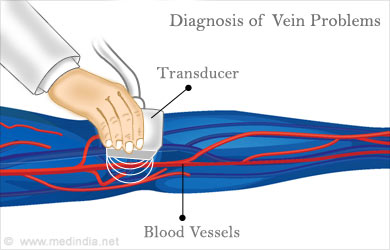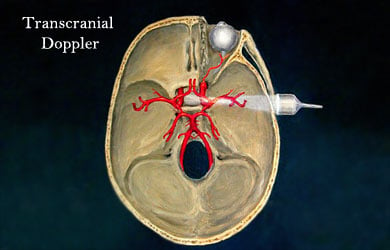- Doppler ultrasound: What is it used for? - (http://www.mayoclinic.org/doppler-ultrasound/expert-answers/faq-20058452)
- Doppler ultrasonography - (http://en.wikipedia.org/wiki/duplex_ultrasonography)
- Transcranial Doppler - (http://en.wikipedia.org/wiki/transcranial_doppler)
- Doppler echocardiography - (http://en.wikipedia.org/wiki/doppler_echocardiography)
What is Doppler Ultrasound Scan?
Ultrasound is a high-frequency sound that you cannot hear but it travels through fluid and soft tissues. However, it bounces back, or echoes, when it hits a more solid, dense surface such as a valve or bile in the gallbladder etc. So, when ultrasound 'hits' structures of different densities in our bodies, it echoes differently with each hit.
An ultrasound scan is a harmless test that uses sound waves to create images of organs. Doppler and duplex scans are used to produce images of blood flow and others fluids in the body. The scan takes about 15-45 minutes, depending on which parts of the body are being examined.'

Why is Doppler Ultrasound Scan done?
Doppler ultrasound scan is a diagnostic procedure, which helps to evaluate and detect abnormalities in the blood flow. A Doppler ultrasound can help in the diagnosis of conditions like deep vein thrombosis, blood clots or embolism.
Doppler test can be effectively used as an alternative diagnostic tool and the results are comparable to more invasive procedures such as arteriography and venography.
Doppler test is done for the following:
- Identify any blood clots and narrowed or blocked blood vessels in any part of the body. It is usually done to evaluate the blood flow in the neck, arms and legs.
- Evaluate location and amount of arterial plaque. The arterial plaque can reduce blood flow to the other parts of the body.
- Diagnose intermittent claudication (tight, squeezing pain in calf, foot, thigh or buttock, occurring during exercise and is relieved by rest).
- Evaluate the blood supply to the brain after a stroke. The procedure is called transcranial Doppler ultrasound.
- Diagnose vein problems like varicose veins

- Identify any heart valve defects and congenital heart disease
- Map veins to identify location for blood vessel grafts
- Check the condition of grafts that have been used to bypass blockage in arm or leg
- Evaluate the blood flow to a transplanted kidney or liver
- Monitor flow of blood during any kind of blood vessel surgery
- Guide during the treatment techniques such as laser or radiofrequency ablation of abnormal veins.
- Assess blood flow in the umbilical cord, through the placenta and heart and brain of the fetus using fetal Doppler scan. Doppler test can show if the fetus is getting enough oxygen and nutrients via the placenta and cord.
- Assess Rh sensitization - Rh sensitization can occur during pregnancy if you are Rh-negative and your fetus has Rh-positive blood.
- Infertility
How is Doppler Ultrasound Scan different from Ultrasound Scan?
Ultrasound scan technique and Doppler ultrasound scan involve the use of ultrasound waves that are transmitted inside the specific part of our body. A probe or transducer is placed on the outside of the body part to be evaluated and it sends in sound waves of very high frequency that are out of the range of human hearing.
In ultrasound scan, waves hit the stationary body parts and bounce back. These returning waves are caught by the computer and images that are created are displayed on the monitor. In Doppler ultrasound scan, sound waves are made to hit a moving object. The reflected sound waves are of a different frequency than the original ones, which help determine the speed of the moving object – namely, blood and pumping heart - inside the body.
Preparing for a Doppler Ultrasound Scan Procedure:
- Avoid nicotine products like cigarette and tobacco for about 2-4 hours prior to the Doppler test procedure. Nicotine causes the blood vessels to constrict and this may be mistaken for a pathological constriction.
- The patient has to remove any jewellery and metal accessories as they may interfere with the examination results.
- The patient is asked to change into a hospital gown, according to the area of the body to be examined.
- For abdominal scan, the patient would be asked to eat low-fiber diet for a day before the test, to minimize gas in the gut.
- Enema may be given for scan of lower abdomen.
Doppler Ultrasound Scan Procedure:
A radiologist or a sonographer is qualified to perform the Doppler ultrasound scan.
The position of the patient depends on the area of the body to be examined.
- For head and neck scans, the patient’s head may be turned to the required side.
- For chest scans, the patient is made to lie on the back with neck slightly extended.
- For abdominal scans, the patient is made to lie on the back.
- For an arm or leg scan, the head of the patient will be slightly raised. The exposed arm or leg will be turned slightly outwards. For some leg scans, the patient may be made to lie on the stomach.
- Doppler scan during pregnancy is done with the patient lying on the back or on the left side with the belly exposed.

A gel is applied to the skin and the probe to facilitate smooth passage of sound waves. The transducer is moved along the skin of the required surface. The patient needs to lie as still as possible during the procedure. Sounds representing the flow of blood through the blood vessels may be heard.
The sound waves of high frequency are sent through the probe into the skin and the blood vessels. The movement of the blood vessels send back echo of a different frequency. The frequencies of the returning sound waves are recorded and the Doppler scan machine calculates the speed of the moving blood.
Types of Doppler Scan
Continuous wave Doppler: This type is also called “Bedside Doppler”, as it can be done with a portable machine to provide a quick estimate of the damage or disease caused by conditions such as stroke. It uses the change in pitch of the sound waves to provide information about blood flow through a vessel.
Duplex Doppler: Duplex Doppler ultrasound uses a combination of standard ultrasound methods to produce a picture of the moving blood and the organs surrounding the blood vessel. The graph formed by the computer using Doppler sounds gives information about the speed and direction of blood flow through the blood vessel being evaluated.
Color Doppler: Standard ultrasound method is used to produce a picture of a blood vessel. The Doppler sounds are converted into colours that are overlaid on the image of the blood vessel, showing the direction of blood flow and its speed.
Power Doppler: Power Doppler uses the amplitude of the Doppler signal to detect moving matter, instead of the frequency of the echo. It allows for detection of smaller velocities compared to colour Doppler and helps obtain information of blood flow through vessels within solid organs.
Doppler Ultrasound Scan of Various Organs
Arteries in the Arms and Legs: Doppler scan is done in both arms and both legs, even if the abnormality is suspected in one limb. This is done so that the vascular system can be compared between the two limbs. Doppler scan for arms are done while lying down and again while sitting. Blood pressure cuff may be wrapped around one or both limbs to record blood pressure at specific points.
For scanning the legs, readings are taken at different locations with a blood pressure cuff first wrapped around the calf and then around the thigh. For scanning the arms, the cuff is wrapped around the forearm first and then around the upper arm to take the readings.
Testing may be done before and after exercise, in required patients.
Veins in the Arms and Legs: The patient is asked to lie still and breathe normally. Changes in blood flow that occur as a response to your breathing patterns are noted. A compression maneuver, pressing the probe close to the surface of the skin on the veins, at different points is done. Augmentation maneuver is the technique of directing a rush of blood flow through the calf veins by pressing and releasing it. This indicates the blood flow towards the heart. Valsalva maneuver, which is performed by breathing out strongly with the nose pinched and the mouth closed, causes sudden change in blood flow through the veins.
Arteries of the Neck or Carotid Arteries: Doppler ultrasound scan done for the two carotid arteries on each side of the neck can help detect narrowing of the arteries. Carotid arteries carry blood from heart to the brain and carotid artery stenosis can increase the risk of stroke. The Doppler scan also helps to locate a hematoma, verify the position of a metal stent placed, detects tumors and congenital vascular malformations. It is done in children with sickle cell disease to predict the risk of stroke.
Transcranial Doppler: Transcranial Doppler or transcranial colour Doppler measures speed of blood flow through the brain’s blood vessels. The test is used for diagnosis of emboli, stenosis, vasospasm, hemorrhage and other related problems. In an Implantable transcranial Doppler, a device is “operatively connected to a drug delivery system”. It is a battery-powered device that helps make the automatic decision to administer the drug in response to early signs of stroke.

Functional transcranial Doppler is a neuro-imaging tool to measure the speed changes in the cerebral blood flow that occur during cognitive tasks such as thinking and decision-making.
Doppler Echocardiography: Doppler Effect of the ultrasound technique can produce accurate assessment of the direction of blood flow and speed of blood and cardiac tissue at any point of time. This technique is non-invasive, yet equally effective in assessing the blood flow in the heart. The method helps in evaluating the cardiac valve areas and their function, abnormal communications between left and right side of the heart, any leaking of the blood through the valves, calculation of cardiac output and much more.
Doppler Scan during Pregnancy: Fetal Doppler is used to measure the blood flow in different parts of the body of the fetus, such as umbilical cord, brain and heart. This helps to find out whether the baby is getting enough oxygen and nutrients that is needed for growth through the placenta. It also helps assess other prenatal factors such as multiple births, rhesus sensitization, growth of the baby and so on.
Uterine Artery Doppler scan can help assess whether enough blood is reaching the placenta. A portable Doppler machine is also available that enables the pregnant woman to listen to the baby’s heartbeat at home, whenever she wants to. However, it should be used with caution as they may possibly raise false alarms.
Risks of Doppler Ultrasound Scan
There is no known risk of a Doppler ultrasound scan. It does not harm the blood vessels, heart, brain, uterine structures or the fetus in anyway. Doppler ultrasound scan is, by far, a safe technique used as an alternative to more invasive diagnostic tools.
False Positive Results of Doppler Ultrasound Scan
Factors that may cause false positive results giving rise to doubts about abnormalities present include:
- Presence of gas in the intestine. Bones above the area being examined in the Doppler scan
- Movement of the patient during the procedure
- Extreme obesity

- Having an open wound in the area to be scanned
- Co-existing medical conditions such as heart disease and arrhythmias could cause changes in blood flow patterns. Blood vessels may be normal in such conditions






